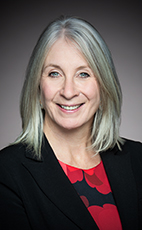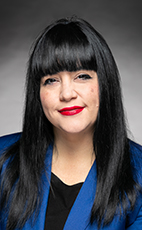44th Parl. 1st Sess.
May 2, 2023 10:00AM
- May/2/23 10:08:39 p.m.
- Watch
Madam Chair, as we debate Red Dress Day today, there is a tremendous amount of support for meaningful action to save lives. However, I wonder if the member for Lakeland has reflected on the recommendations in the inquiry for missing and murdered indigenous women and girls and two-spirit peoples. We have had those recommendations now for years, and they have not been implemented. I wonder if the member has any thoughts on which ones she believes would be the most meaningful as well as creating this new alert.
89 words
All Topics
- Hear!
- Rabble!
- add
- star_border
- share
- May/2/23 10:10:49 p.m.
- Watch
Madam Chair, I am sharing my time today with the member for Saanich—Gulf Islands.
It is an honour to speak in this place, located on the traditional and unceded territory of the of the Algonquin Anishinabe people. “Unceded” is another word for “unsurrendered”, which means taken without permission or agreement, like so many of the women and girls we will remember today, who were taken by force from their families and loved ones.
I am from the traditional territory of Fort William First Nation, and I represent a vast geographic area that includes many first nations communities that have been deeply impacted by decades of racist policies imposed by colonialism. Of course, my region is home to indigenous women and girls and 2SLGBTQQIA+ people, who have to fight daily for dignity, safety and their inherent right to exist in their communities and hometowns. All across my riding and indeed this country, many have disappeared, been tortured or died despite these efforts and those of their families. Many indigenous women and girls exist daily with threats, intimidation and overt racism.
Friday is Red Dress Day, a sacred day to remember sisters, daughters, aunties and loved ones. Each dress serves as a reminder of a life that ended too soon and is a recognition of those who are living in constant fear. This is the reality for indigenous women and girls. It is a manifestation of a country formed by displacement, a colonial and patriarchal system imposed on indigenous culture and a dehumanization of indigenous lives and bodies, especially of women and girls.
The recent discoveries of the bodies of women in Winnipeg dumps are horrific examples of these long-held perspectives. How much clearer can it be? Despite public outrage, it was not as shocking as it should have been. After all, finding naked, raped indigenous bodies is something many Canadians have heard about for a long time.
The first time I heard this was with the discovery of the body of Sandra Johnson, who was murdered in February 1992, her body dumped on a frozen river and the crime still unsolved. There are so many names, including Rena Fox from my region, a mother of four who was murdered in February 2003, her body dumped on a rural road, her four children left without their mom and her killer still at large. They are just two women in a list that is so long, and the stories go on and on.
Eighty-one per cent of indigenous women who are placed in child welfare systems will experience physical or sexual violence. Imagine that. A system with the stated goal of protecting children is doing exactly the opposite.
Changing colonial, patriarchal systems is not easy work. Governments at all levels must invest and change laws. Organizations must change governance and add indigenous people and, importantly, cede power.
However, change is happening. I have had the immense honour of signing four agreements with indigenous nations and the provinces to return care and control of family services to communities. A total of seven of these agreements are in place, with more under way. Each ceremony is extremely moving, with a recognition of loss and the hope of healing.
This spring, the government signed an amended settlement agreement to compensate first nations children and their families who suffered harm and pain by Canada's discriminatory underfunding of the child welfare system. This settlement is an expensive reminder to Canada that fiscal discrimination must end and has no place in the budgets of Canada or any order of government.
The federal Liberals ended long-standing discrimination in primary and secondary education funding, are investing to close the infrastructure gap and are taking significant steps to ensure economic reconciliation. These are all important factors in protecting women and girls, as the national inquiry's final report noted. Called the “social determinants of health”, they help to prevent violence, abuse and risks that lead to murdered or missing women and girls.
For the decade under Stephen Harper, the party opposite refused calls for a national inquiry into the situation of missing and murdered indigenous women and girls, and it maintained inequities in funding for water, infrastructure, child welfare and education. However, in 2016, the Liberal government launched that inquiry and reformed the way education is funded. The government set provincial education formulas as a new minimum base, and agreed to modifications that address specific first nations needs and priorities. To match the policy, the government invested $781 million, increasing the national education funding formula by 52%.
The way to make a difference for indigenous women and girls is through the tools of equity and self-determination and through a relentless commitment to truth. Then and only then will we see an end to this tragedy. We have begun this work with indigenous peoples and we must be relentless in the next steps.
823 words
All Topics
- Hear!
- Rabble!
- add
- star_border
- share
- May/2/23 10:16:56 p.m.
- Watch
Madam Chair, I appreciate the comments by the member opposite, in particular about retraumatization of victims. I agree, and I am grateful for the reminder. I have also reflected on the fact that it is difficult to discuss this without, for me at least, reflecting on the serious and ongoing nature of the violence that women are facing every single day. However, it is an important point in terms of how I speak about this, particularly in public forums.
In terms of the budget and the alert, the commitment of this government is clear. We have invested historic amounts of money in many of the calls to action that are very significant, including, for example, closing the infrastructure gap and some of the inequities that exist in child welfare and education, as well as the very difficult job of closing a number of other gaps that put women, girls and, indeed, all indigenous people at risk.
We are going to continue that work. It is not easy, and it is not simple, but it is certainly worthwhile.
177 words
All Topics
- Hear!
- Rabble!
- add
- star_border
- share
- May/2/23 10:18:54 p.m.
- Watch
Madam Chair, I can say that this government is laser-focused on all the calls to action. I will work with my colleague, the Minister of Crown-Indigenous Relations, to make sure that we are doing this in an appropriate fashion, in full consultation with indigenous partners and in an expeditious way to ensure that there are as many tools as possible to protect indigenous women.
I will say, as the Minister of Indigenous Services, that my focus remains on the social determinants of health, on the preventive factors that actually lead to families that remain intact and reduce the risk factors for women and girls that many members in this House have spoken to. The risk factors are increased by things like poverty, exclusion, racism and underfunding. I continue to focus on them in the work that I do, day in and day out.
145 words
All Topics
- Hear!
- Rabble!
- add
- star_border
- share
- May/2/23 10:19:48 p.m.
- Watch
Madam Chair, one issue is of particular concern for indigenous peoples. The minister talked about education as a key component in supporting opportunities. In British Columbia, one of the first acts of the former minister of advanced education, Melanie Mark, was to ensure that children in care and coming out of care would have access to free education in British Columbia.
If the minister really believes in supporting indigenous, Métis and Inuit peoples to thrive, would she call publicly for the government to fund an educational program for all indigenous peoples across the country who are coming out of care?
102 words
All Topics
- Hear!
- Rabble!
- add
- star_border
- share
- May/2/23 10:20:45 p.m.
- Watch
Madam Chair, in fact, part of the work that the government has been doing is to improve what is called postmajority care for people coming out of the child welfare system and ensuring that supports extend beyond these people's emergence from the system.
I want to pick up, though, on the member opposite's rightful focus on post-secondary education. It is wonderful that B.C. is pursuing this. It is an example of a partnership with a province that can go a long way. In fact, I think we have an untapped source of incredible talent in indigenous peoples, and I spend a lot of my time thinking about how we can accelerate—
116 words
All Topics
- Hear!
- Rabble!
- add
- star_border
- share
- May/2/23 10:21:41 p.m.
- Watch
Madam Chair, it is an honour to stand here on the lands of the Algonquin Anishinabe people. To them I say meegwetch.
I am moved to say the power of the red dress symbol has been overwhelming. One moment that indicates the power of the red dresses hanging empty of the women's bodies who should be living and walking with us was the RCMP's reaction to the Fairy Creek encampment of largely indigenous land protectors and forest defenders. In a certain part of the Fairy Creek protest area they had hung red dresses everywhere. The violence with which the RCMP made sure they tore down all the red dresses and threw them away was indicative of some of the larger problems I think we face in terms of the culture of violence and racism.
The report of the missing and murdered indigenous women and girls, two-spirit plus inquiry made it very clear that when they looked at the culture within law enforcement, it was largely defined by colonialism, racism, bias and discrimination. There are many important recommendations in the inquiry that we have had now for so many years, and so many recommendations have not been implemented. I think of the recommendation that if we want to stop a genocide of indigenous women and girls, we need a guaranteed livable income to ensure that no one lives in poverty.
It is pretty obvious that indigenous women and girls are going missing because the only way to get anywhere is to hitchhike. They are vulnerable and not safe as there is no public transport. What are they to do? The inquiry called for safe and reliable public transportation, particularly in our remote and rural areas. It also called for an end to man camps, the resource exploitation camps. Obviously, it is not universal and it is not all the men who work there, but many times there is a direct correlation between the man camps that build pipelines and dams and the exploitation and killing of women.
In the report after re-reading it in light of tonight's debate on Red Dress Day, we become very aware of a tone of voice, a framing, a verb tensing throughout the report, which is really about trying to find justice for the women who have disappeared, trying to solve the cases for the women who have been killed, to look at systemic changes throughout society. There are over 50 pages of calls for justice and very important recommendations, but the tone of voice and the tensing is around finding out what happened to women and girls who have been gone a long time. It does not speak to the urgency of how we stop this genocide.
The hon. member for Winnipeg Centre has said frequently in this place that she is at ground zero for the assault on women and girls, but we also know that sometimes indigenous women and girls are killed and we know who killed them. Chantel Moore was killed on June 4, 2020, by a member of the Edmundston police force. We know his name. We just do not know why he chose to kill Chantel Moore. We have a police culture problem. We have an urgent need to make sure the police, when an indigenous woman or girl goes missing, respond the same way they would as if it were their own sister, daughter, mother or wife who had gone missing.
That does mean that we change our verb tense. That means we stop looking back at things that have happened and find ways to try to make them right, that we provide the services for women who have been assaulted. Many recommendations in the report go to that, but nowhere in the inquiry for murdered and missing indigenous women and girls do we find anything as immediate and proactive and life-saving as saying we need a red dress alert. We need people's phones to go off. We need people to go out and look, just as we do on an Amber Alert for a missing child. We need to actually take the steps that are required for one of our dear, dear friends; mothers, daughters, aunties, sisters.
Every indigenous woman I know has lost someone close to her. It must stop.
720 words
All Topics
- Hear!
- Rabble!
- add
- star_border
- share
- May/2/23 10:29:15 p.m.
- Watch
Madam Chair, as part of this discussion about indigenous women and girls and two-spirited people, I think about the 2SLGBTQ+ community and how the recent rhetoric harming the trans community feeds into some of the issues we are seeing around missing and murdered indigenous women. I am wondering if the member could comment on that.
56 words
All Topics
- Hear!
- Rabble!
- add
- star_border
- share
- May/2/23 10:32:10 p.m.
- Watch
Madam Chair, it is with a great deal of emotion that I rise this evening on behalf of the Bloc Québécois to close this debate after my incredible colleague from Manicouagan, who spoke earlier this evening.
From the outset, I would like to remind the House that our political party has repeatedly reiterated its commitment to being an ally to the first nations. We believe that it is critical that we collectively remember all missing and murdered indigenous women, girls and 2SLGBTQIA persons to honour their memory.
I will go over some of our proposals, and then I will talk about Red Dress Day. I will close my speech by reminding the House of the origin of the National Inquiry into Missing and Murdered Indigenous Women and Girls.
First, we called for the creation of the National Inquiry into Missing and Murdered Indigenous Women and Girls and we supported its findings. We continue to support initiatives aimed at ending the impact of Canadian colonialism on indigenous peoples.
The government has been slow to implement some calls to justice. Although it publicly underlines the importance of reconciliation, the chronic underfunding of indigenous people in Canada continues. The federal government's inability to make sufficient investments in social and affordable housing, health services and infrastructure, water in particular, in indigenous communities has devastating consequences for indigenous people, their families and communities, in particular indigenous women and girls.
Massive efforts and investments must be made to honour the federal government's commitments and put an end to the crisis being experienced by indigenous women. The investments being made are insufficient to erase the harmful effects of colonialism. The resulting trauma is still deeply felt today and keeps women in particular trapped in a cycle of violence and vulnerability.
The Bloc Québécois is calling for true reconciliation. It must be social, cultural and economic. It must enable indigenous people to free themselves from the harms they were subjected to, and it must be done with the communities, not by imposing a Canadian vision of what reconciliation is.
The Bloc Québécois has always been a strong advocate of nation-to-nation discourse, and we reiterate that position once again. May 5 is Red Dress Day, the National Day of Awareness for Missing and Murdered Indigenous Women and Girls. It is a time to honour missing and murdered indigenous women, girls and 2SLGBTQIA+ people. We believe that one way to do this is by accelerating the implementation of the calls to action of the National Inquiry into Missing and Murdered Indigenous Women and Girls and the United Nations Declaration on the Rights of Indigenous Peoples.
Second, Red Dress Day is about honouring the victims, raising awareness of this crisis and encouraging governments to take action to address racist and gender-based violence against indigenous people in Canada.
I saw the REDress Project, which is now a permanent exhibit at the Canadian Museum for Human Rights, when I visited Winnipeg for a symposium on human trafficking and the resulting sexual exploitation that disproportionately affects indigenous women and girls, who often wind up missing or murdered.
Third, I would like to talk about how the national inquiry came about. In 2014, the issue finally broke into the headlines as a potential systemic problem after the RCMP unveiled its figures on the number of missing and murdered indigenous women and girls. The numbers speak for themselves. A total of 1,007 indigenous women and girls went missing or were murdered between 1980 and 2012. There are still 105 women unaccounted for, who disappeared under unexplained or suspicious circumstances. Between 2004 and 2014, as the murder rate fell across Canada, six times more indigenous women and girls were murdered than non-indigenous. Taking advantage of the momentum generated by the Truth and Reconciliation Commission's work, many groups held demonstrations on October 4, 2014, demanding a national inquiry into the causes of the disappearance and murder of indigenous women and a national action plan.
It is also important to note that there is still a disproportionate number of indigenous women in Canadian prisons, many of whom were victims of violence themselves. That being said, pressure was mounting on the federal government, which until that point had ignored all calls for action.
Less than a year later, in 2015, the Truth and Reconciliation Commission of Canada called for a national inquiry into the disproportionate victimization of indigenous women and girls.
On June 3, 2019, the National Inquiry into Missing and Murdered Indigenous Women and Girls released its final report, “Reclaiming Power and Place”, after more than two years of gathering testimony from indigenous knowledge keepers, experts, and 1,484 survivors and family members of missing and murdered women and girls.
The report contains 231 separate calls for justice. These are legal imperatives, not mere recommendations. They call for immediate action and are directed at indigenous and non-indigenous governments, institutions, social service providers, industries and Canadians from all walks of life.
In Canada, according to 2018 figures, 25.1% of non-indigenous women reported having been physically or sexually abused by an intimate partner, while this percentage rises to 43.7% among indigenous women. Furthermore, 38.2% of non-indigenous women have been physically or sexually abused by someone other than an intimate partner, but this percentage rises to 54.9% among indigenous women.
Internationally, Canada finally signed on to the United Nations Declaration on the Rights of Indigenous Peoples on June 21, 2021, when the related act received royal assent. This is one of the most important human rights issues facing Canada. The purpose of the act is to affirm the UN declaration as an international human rights instrument that can help interpret and apply Canadian law. This act requires the Government of Canada, in consultation and co-operation with indigenous peoples, to take all measures necessary to ensure that the laws of Canada are consistent with the declaration, to prepare and implement an action plan to achieve the objectives of the declaration, and to table an annual report on the progress made in aligning federal laws with the action plan.
The act requires that the action plan include measures to address injustices, combat prejudice and eliminate all forms of violence, racism and discrimination against indigenous peoples, including elders, youth, children, persons with disabilities, women, men and two-spirit and gender-diverse persons. It aims to to promote mutual respect and understanding, as well as good relations, including through human rights education. The plan must include measures related to the monitoring, oversight, follow-up, recourse or remedy or other accountability with respect to the implementation of the declaration. This action plan must also include measures for monitoring the implementation of the plan itself and for reviewing and amending the plan.
In their descriptions of encounters, families and survivors who spoke at the national inquiry consistently linked their experiences to colonialism, both historic and modern forms, in one of the following four ways: historical, multi-generational and inter-generational trauma; social and economic marginalization; maintaining the status quo; institutional lack of will; and refusal to recognize the expertise of indigenous women and girls and their capacity to act. The Canadian government and the clergy planned the collective trauma with the ultimate goal of driving all indigenous communities to extinction. Those communities have since been left to deal with the consequences alone.
We might say that indigenous communities need to fight. Quebeckers and Canadians alike need to be aware of the collective trauma experienced in these communities, understand it and make sure these atrocities never happen again. In listening to the testimony of indigenous women, Quebec Native Women counted four types of violence: structural violence, institutional violence, family violence and personal violence. That last type of violence covers actions such as physical violence, psychological manipulation and financial control, and it involves individuals.
In conclusion, the government must act on the report of the National Inquiry into Missing and Murdered Indigenous Women and Girls on the occasion of Red Dress Day, which seeks to raise awareness of this problem. We are calling on the government to take concrete measures to protect indigenous populations, to recognize the disproportionate level of violence faced by indigenous women and to stand in solidarity with them. We must commit to putting an end to racism and systemic violence against indigenous women, girls and two-spirit people. As elected officials, we must take action and not settle for a simple speech about this situation.
I would like to point out one last thing because the numbers speak for themselves. In a report released in May 2014, the RCMP documented 1,181 cases involving indigenous women, including 1,017 who were murdered and 164 who went missing, between 1980 and 2012 when this all happened. Some estimate that more than 4,000 indigenous women are missing. According to the national inquiry, it is impossible to determine the exact number of murdered and missing women.
The fake feminism must stop, and there must be action.
1527 words
All Topics
- Hear!
- Rabble!
- add
- star_border
- share
- May/2/23 10:43:44 p.m.
- Watch
Madam Chair, one thing is certain. It is well worth looking into this issue of the alert.
In my speech, I talked about the government and about us as elected officials. I talked about the wrongs that have been done over the years. Since we are talking about action, I think that we are at the point now where we need to raise public awareness of this issue and recognize that missing and murdered indigenous women and girls do not receive the same treatment as others do.
Finally, this type of alert could perhaps make people aware of the fact that indigenous women do not get the same treatment when they go missing and that people are not as concerned about them. That is probably what the red dress alert system could be used for. I know that my colleague from the Standing Committee on the Status of Women firmly believes in it, and I think it is worth looking into. After that, if it is worthwhile, then the government will have to provide funding and walk the talk.
179 words
All Topics
- Hear!
- Rabble!
- add
- star_border
- share
- May/2/23 10:46:30 p.m.
- Watch
Madam Chair, there is a clear link between women who are victims of violence, both indigenous and non-indigenous, and precarious financial situations.
We must work on making these indigenous women and girls financially self-sufficient again. There are many ways to give them the financial means they need to escape the cycle of violence. I mentioned it in my speech.
My colleague spoke about the committee. I am certainly frustrated to note that every time we talk about a study, we find that indigenous women are disproportionately affected. Why? It is because they are trapped in a cycle of poverty and insecurity.
We recently studied the situation of women in the resource development industry in western Canada to determine how and why, in those cases, women are victims of sexual violence. Why are they? It is because they, too, are kept in a cycle of poverty. It is because the government does not invest enough in infrastructure.
There are so many ways to improve all that and to financially empower indigenous women and girls so they can finally escape the cycle of violence.
I completely agree with my colleague. We have to think about giving them back their self-sufficiency and empower them to move away from their attackers and oppressors and escape the cycle of violence.
218 words
All Topics
- Hear!
- Rabble!
- add
- star_border
- share
- May/2/23 10:48:04 p.m.
- Watch
Madam Chair, I thank my colleague for her commitment to the cause of indigenous women and girls. I have a question for her.
She mentioned something that I said myself earlier. Last year, we were here talking about the same subject. Despite the fact that we likely think about this every day, I still feel we are not making any progress.
Where would my colleague like us to be at this time next year? Why does she think that so little progress has been made to date?
87 words
All Topics
- Hear!
- Rabble!
- add
- star_border
- share
- May/2/23 10:51:04 p.m.
- Watch
Madam Chair, one thing is certain: An alert system could engage the public. I answered that question earlier.
Beyond what we as elected officials can do and what the government can do, there is also a need to raise public awareness of this issue. I hope that we can open up a broader debate and make people aware of the fact that, in 2023, indigenous communities are disproportionately victimized. We need to realize that they are victims of a precarious situation because we put them there and that we do not care enough about them. There is a pressing need to talk to each other nation to nation, to make people aware of the different challenges that affect indigenous communities. Beyond the fact that it could make us think about saving lives, could this alert allow us to open up a debate with the public?
That is also what an alert is for. That discussion needs to take place. It is one way to get the issue out of the House of Commons and into the world and to make as many people as possible aware that we need to talk to each other.
195 words
All Topics
- Hear!
- Rabble!
- add
- star_border
- share
- menumenu
- notificationsnotifications
- home
- mailmail
- searchsearch








